Here I am after a very long day involving meetings, and sending reports from home afterwards. Of course I was shattered by the end of it so instead of making the same mistake as yesterday I decided to take a proper 1:30 hour nap (the full sleep cycle) and here I am feeling pretty refreshed and excited for these nest 2 to 3 hours of GMAT study.
Arithmetic
How beautiful this word “Arithmetic” I feel like some old Greek sage about to be enlightened. Let’s do this. There +30 videos in this series. Looking forward.
First explain the associative, commutative properties… no need to explain, is very basic. It is still interesting to see how these stuff one has interiorized from high school. For example the Distributive property means a(b+c) = ab + ac. This is something already we do automatically thankfully 🙂 So it is NOT true one forgets EVERYTHING in education.
Ok this again caught me TOTALLY off guard:
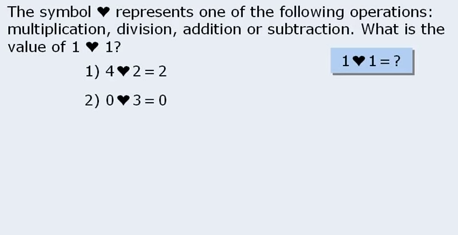 First of all because I guess it’s not “clear” its a Data sufficiency question, maybe if the answer choices will be there I’d have realized… but anyway.
First of all because I guess it’s not “clear” its a Data sufficiency question, maybe if the answer choices will be there I’d have realized… but anyway.
I TOTALLY became overconfident and disregarded this question… obviouslu statement 1 is insufficient cause heart could be division or substraction. Then statement two could be division or multiplication… hence using both statements one finds heart is division? WRONG
I need to be EXTREMELY CAREFUL HERE AND MAKE A VOW to approach DS questions in a particular way, or Ill be in trouble. Let’s analyze if statement 2 is sufficient on its own. Well heart could be division or multiplication right? so 1 heart one… is 1 ! no matter if we use division or multiplciation, hence the statement 2 is ENOUGH and SUFFICIENT to answer the question.
Rule 1: OVERCONFIDENCE WILL KILL ME . Treat EVERY question with maximum care, maxium concentration, or don’t do the GMAT. I vow to never underestimate a question again.
Then video explains how to deal with different sign etc… again this I know from high school.
Absolute value = is the number’s distance from 0 on the number line. (Hence abs(-2) is 2)
Decimals
Damn, dividing and multiplying decimal numbers is boring :S Anyway, let’s not enter into a negative cycle. Good thing is I refreshed how to do it.
Rounding
If 1 to 5 included then round up.
Multiply and divide powers of ten
Again this is easy, no need to explain.
Consider this exercise:
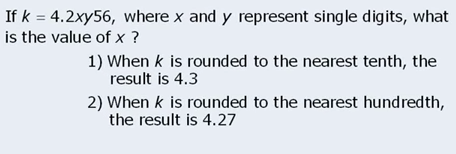 Now the crazy thing is that again, although this time I did everything right, at the very end I ALMOST really messed up. By saying both convined are sufficient when clearly not.
Now the crazy thing is that again, although this time I did everything right, at the very end I ALMOST really messed up. By saying both convined are sufficient when clearly not.
NEED TO NOT ONLY TAKE QUESTION SERIOUSLY, BUT TAKE METHOD VERY SERIOUSLY, SAY IT OUT LOUD. I VOW TO NEVER MENTALLY DECIDE AN ANSWER AGAIN. BEFORE ANSWERING AND MOVING ON I WILL EXPLAIN WHY THE ANSWER IS WHAT I CHOSE.
Fractions
Basic stuff no need to explain.
Video suggests to memorize this table
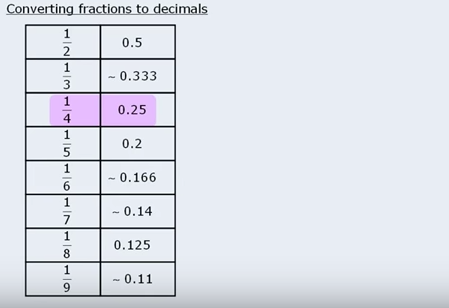
You know I don’t like memorizing so I won’t. (Also its quite quick to calculate those by doing a brute force division if required). Later if I find myself in a situation when this would have saved my life… I’ll come back here and memorize.
Decimals to fractions
Lol, I thought this was something I hadn’t done but its obviously not. 0.35… I just multiply by 100 so 35/100 hence 7/20 etc.
Undefined n/0
n/0 is undefinded. If for example 6/0 gave us a result R, then 6 should equal 0*R which is not possible obviously. 0/0 also undefined
Properties of fractions
Hmm… not hard enough to be worth writing here. Basically if you had good high school math you will remember this already.
Just one observation… for example in this question:
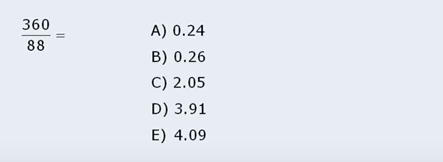
Here I just reduced the fraction to 45/11 which clearly 11 is at least 4 times in 45… so then I thought… why didn’t you do it to start with? Sure… If a bit quicker I could have realized that 360/88 is just 360 divided into 88 which just means “how many times is 88 in 360” whose answer is clearly > 4. (although one could get confused with the 3.91 answer… so reducing the fraction to 45/11 makes it more clear that for sure 11 is at least 4 times in 45.). Better to play it safe I guess.
Property: If you increase numerator and denominator by same amount, fraction approaches 1… this makes sense because imagine u add 10000000 in both top and bottom, of course it will approach 1.
Check this question:
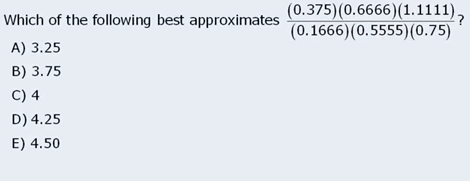
Now interestingly it took me 4 min to find some answer which turned out to be wrong and was not able to actually find a quick smart way to find a proper answer… well after looking at the solution it turns out this is complete Bullshit. There is no smart way to do this? Basically the guy just says… ok, remember the table you memorized? U can clearly see that 0.375 is 3 times 1/8 … WTF. Seriously? Ok this is annoying. I mean, GMAT is supposed to test logic etc… not this kind of pointless memorization.
Ok so having found this… I think I will have to kind of memorize the table… let’s try.
First of all, I am trying to memorize all fractions with num 1 and den n going from 2 to 9. Let’s start. 1/2 is obviously 0.5 (I guess one does “memorize” sometimes ;P but I would call it “interiorizing” instead). 1/3 actually it’s 0.333333 and this also I know… should have seen that 0.6666 is gonna approx be 2/3. then 1/4 is 0.25 easy. then 1/5 is 0.2 easy… 1/6 I din’t know but it seems it is 0.166666 indeed… so I will keep that in mind. Easy to remember cause sixes match. 1/7 it seems its 0.14 approx (although more decimals are there if one does the brute force division). 1/8 is 0.125 and 1/9 seems 0.111 approx.
Main takeaway: I could have actually, if I had a colder head, calculated each of the above quickly by doing brute force calculation. I guess what stopped me was the thought that “there must be a smarter solution”. It was unthinkable for me that one had to just know, what each of those decimal numbers translated into… honestly. And just brute forcing a multiplication and division with decimals was out of the question.
So I take the learning and move on.
Percents
Again suggests to memorize table
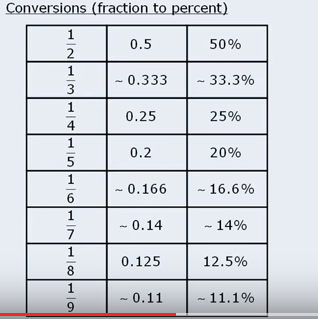
Is same as before actually… so hmm… shouldn’t be a problem!
Interesting technique:
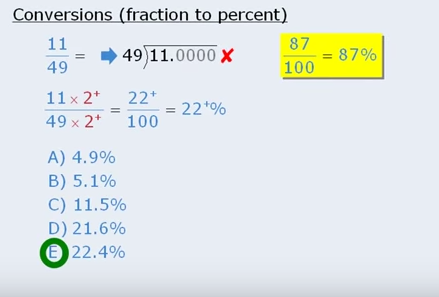
I like this technique. Saying… ok what number I need to multiply denominator to get 100… answer is a num slighly bigger than 2. So I can also multiply top by a number slightly bigger than 2… hence it is clear that answer is slightly bigger than 22%. Love it.
This question took me 3m 14s to find the answer… because I complicated myself:
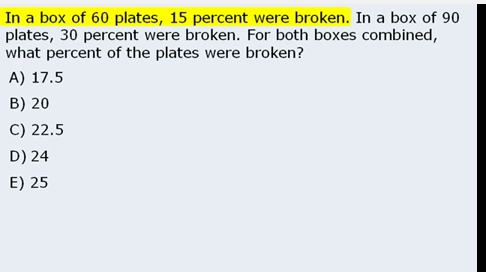
I need to be very careful not to mess up easy questions like this. In this case I quickly found out % was 36/150 but then complicated myself simplifying the expression etc… I honestly should have just brute force divided it to find result was 24.
Alarm sounded 2 hours went by. Will put 1 more.
Percents increase and decrease
Here just need to be careful to divide the difference by the original number not the end number. That’s very important.
Here this question:

Now I solved it well in 2m 40 s which is failure, using equations etc. Actually if I had just assumed price initial is 100, then would have been much easier. Solved in 55s using the method suggested by the video.
Also I need to be extremely careful… if pop is 60 and increases by 300%… new population is? CAREFUL . Again I underestimated this and just said 180… WRONG. I am forgetting to add the original to the increment so its 240. Seriously I need to stop rushing or I am gonna have problems. It is true that I am watching videos ar 2x speed and I know this topic I already kind of now so I am less careful… but it is not an excuse.
Simple interest rate
This I didn’t know the formula. Interest = principal* rate * years. But after seeing it it becomes obvious that yes, this is what it is.
Compound interest rate
Now if need to find exact then no way one can do it manually. So definitely MUST know formula for this one.
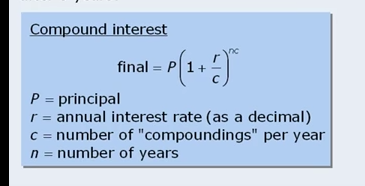
Above is the formula. THANKS GOD it seems that one doesn’t need to evaluate. That’d be impossible really without a calculator as u can get a number to the power of a very big number. When solving the problem I was wondering what I was missing.
MOREOVER, careful… as the question might specify the compounding hapens quarterly for instance… so c = 4. I missed reading that properly… careful.
IMPORTANT TRICK
If the number of compoundings is small… it might just be easier to calculate the % directly. So in question below:
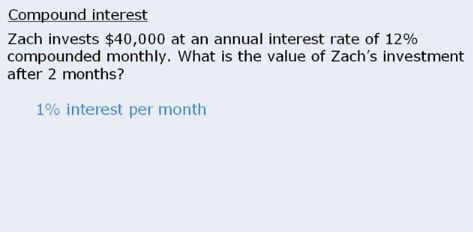
I tried the formula and got confused… hmm but honestly to do the method above one needs to know that 12% compunded monthly means 1% monthly. This I wasn’t aware.
Ratios
Seems simple enough to not need to go deep into examples. Some tricks are useful however. For example. Bruce has 15 cookies, which he will give to K and P in a 2 to 1 ratio. How many cookies does K and P receive? So here I did the calculation etc… butwould have been easier to realize that… for every 3 cookies K receives 2 and P 1. So for every 3 group of cookies, K receives 2 and P 1. Hence we divide 15 by 3, so easily we see K receives 10 and P 5.
Alarm sounded, will try push 30 min more as almost done with the Arithmetic series.
I am getting a bit tired. Got a ratio question all good but was making mistakes in the basic calculations. Need to be very careful.
Another question hapened the same… I am making mistakes when multiplying basic numbers. I need to practice my basic multiplication
Okafter 1:30 hours more I finished the arythmetic. Not happy fully because its almost 3am. I shouldn’t do this 🙁
Anyway, next time Ill take more care.




[…] GMAT Day 4 – Arithmetic, Percents, Interest, Ratios […]